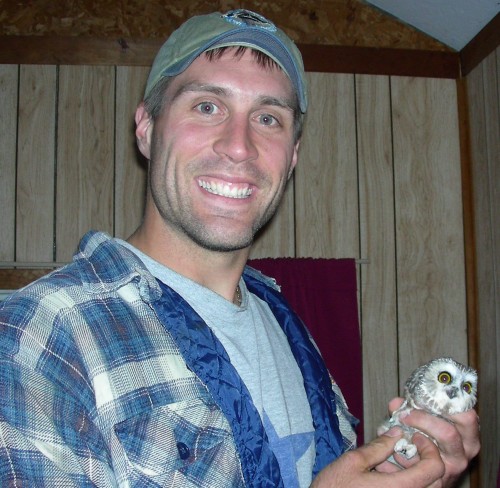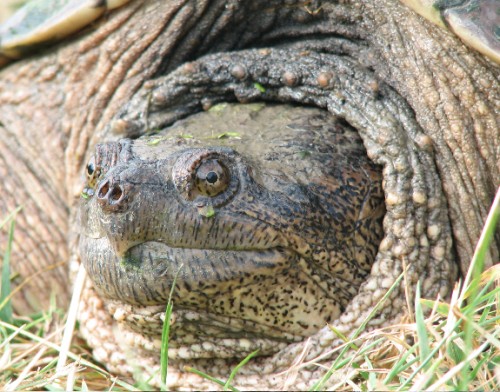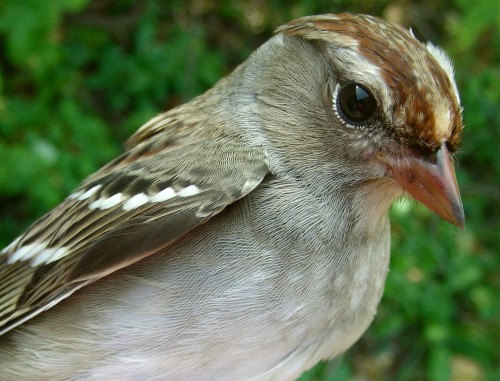|
|
THIS WEEK |
THIS FALL |
2007 TOTAL |
SITE TOTAL |
|
# birds (and species) banded |
311 (33) |
1519 (71) |
2303 (83) |
11621 (102) |
|
# birds (and species) repeat |
72 (17) |
373 (39) |
488 (44) |
2037 (59) |
|
# birds (and species) return |
0 (0) |
42 (12) |
127 (24) |
327 (29) |
|
# species observed |
74 |
132 |
155 |
189 |
|
# net hours |
369.6 |
3942 |
6441.8 |
20464.6 |
|
# birds banded / 100 net hours |
83 |
38.5 |
35.7 |
56.7 |
|
|
Note: table does not include nocturnal banding (owls) |
Banders-in-charge: Marie-Anne
Hudson, Barbara Frei
Assistants: Jean Beaudreault, Kristen Brochu, Veronik
Campbell, Sophie Cauchon, Shawn Craik, Diane Demers, Jean Demers, Kait
Farrell, Peter Hall, Jeff Harrison, Gay Gruner, Joelle Guillet, Helen
Leroux, Alex Liautaud, Barbara MacDuff, Alyssa Macleod, Jennifer
MacWilliam, Mike Mayerhofer, Sophie Mazowita, Annie-Claude Paradis,
André Pelletier, Leigh Piercey-Brunet, Greg Rand, Katleen Robert,
Marc-André Robert, Emilie Roy-Dufresne, Stephanie Steves, Anna Solecki,
Krystal Swift, Rachel Theoret-Gosselin, Shona Watt
Notes: This week was our biggest week of the year so
far, by over 100 birds! This increase is largely due to the 112-bird
day on Friday, but overall there were noticeably more birds around this
week despite some unseasonably warm temperatures (maybe the seasonably
cool start to the week helped). Granted even this busy week involved
over 200 fewer birds than the rush we faced at the same time last year,
so the trend of a quieter-than-usual season continues. On the
other hand, it’s getting more and more difficult to add new species to
our seasonal lists since we’ve had a great season in terms of species
diversity (if not individual abundance). This week, however, we were
able to add Pine Warbler and American Tree Sparrow to our observed
species list. We missed out on new species banded though, for the first
time this season.
Though
we’re still banding lots of warblers, a distinct shift in our bird-life
has occurred, and is visible in the top 10 list of birds banded. The
sparrows are taking over! Whether it’s White-throats (still leading the
pack), White-crowned (vaulting up to third spot), Song or Swamp (both
reappearing in large numbers after laying low for a while), or the more
elusive Lincoln’s and Chipping Sparrows, the sparrows have a definite
foothold at MBO. We’re also in the midst of a Black-capped Chickadee
invasion, with increasing numbers of young birds being banded on a daily
basis. Time will tell what this coming week will hold -- perhaps more
peck-happy friends? The northeastern population has shown a
tendency to move south in much larger numbers in "odd" falls over the
past decade or so, and we experienced a big movement in 2005, so this
might be the start of something.
As was noted in last
week's report, the scarcity of Yellow-rumped Warblers this fall is very
noticeable in comparison with 2006. In fact, comparing just this
week, they alone account for almost the entire difference in bird volume
between the two years: 236 banded in week 9 last year versus just
12 this year (in comparison, there were 309 birds of other species in
2006 and 298 in 2007). Also of note, Ruby-crowned Kinglets last year at
this time were outnumbering White-throated Sparrows in the nets by a 2:1
ratio and this year that has been more or less reversed. However,
the kinglets have in the past few years tended to peak around
Thanksgiving, so the next week should give us a better sense of their
numbers this year.
|
This week’s
top 10
[last week’s rank in brackets]
|
#
individuals banded |
mean # individuals observed daily |
|
1.
White-throated Sparrow (96)
[1] |
1.
Canada Goose (433)
[2] |
|
2.
Ruby-crowned Kinglet (45)
[3] |
2.
American Crow (106)
[1] |
|
3.
White-crowned Sparrow (22)
[-] |
3.
Red-winged Blackbird (75)
[10] |
|
4.
Black-capped Chickadee (16)
[7] |
4.
White-throated Sparrow (60)
[4] |
|
5.
American Goldfinch (15)
[2] |
5.
Common Grackle (56)
[3] |
|
6.
Song Sparrow (15)
[4] |
6.
American Robin (42)
[5] |
|
7.
Swamp Sparrow (13)
[8] |
7.
Blue Jay (28)
[8] |
|
8.
Yellow-rumped Warbler (12) [-] |
8.
Black-capped Chickadee (22)
[7] |
|
9.
Blue-headed Vireo (8)
[-] |
9.
Ruby-crowned Kinglet (15)
[-] |
|
10.
American Robin (6)
[-]
10. Western Palm Warbler (6) [7]
10. Slate-coloured Junco (6) [-] |
10.
American Goldfinch (15)
[9] |
|
The top
10 observed list is fairly similar to last week’s, with the blackbirds
holding their own across the board, unlike last year, when both Common
Grackles and Red-winged Blackbirds were very scarce during this period.
The number of Canada Geese going over on a daily basis is always nice to
see, their honking advertising their presence well before they come into
view. If only all species were that cooperative with our observers!
Blue Jay numbers this week are also noteworthy, with nearly 30 per day
being well above normal numbers at MBO. Large flocks of them have
also been seen streaming alone the northern shorelines of Lakes Ontario
and Erie over the past week, reflecting an unusually significant flight
for this irregular migrant.
|

Exciting news on the owl front! Our first effort since October
2005 netted us a third-year Northern Saw-whet Owl on Sunday
night. We’ve heard from other observatories that this is a
great year for owl banding, so our resident owl-man Shawn Craik
decided to give our owl program a try. Fingers are crossed that
this little guy/girl is one of many! (Photo by Marie-Anne
Hudson)

Where there are babies, there’s usually a momma lurking
somewhere nearby. Barbara reported that this huge Snapping
Turtle was very well behaved and amazingly nimble. (Photo by
Barbara Frei)
|



